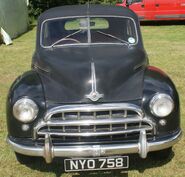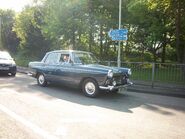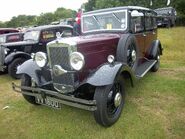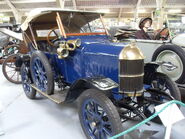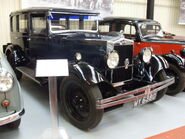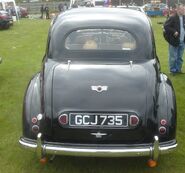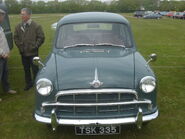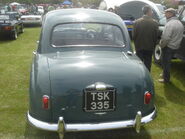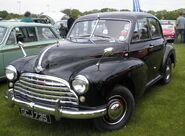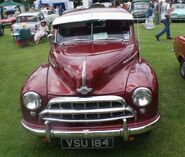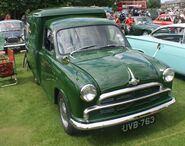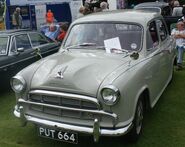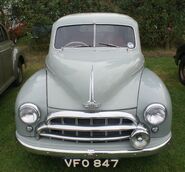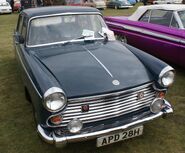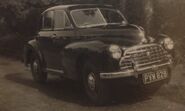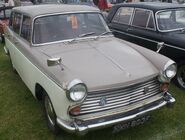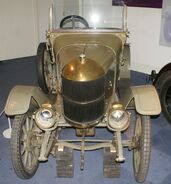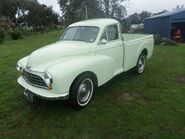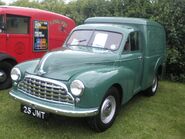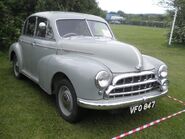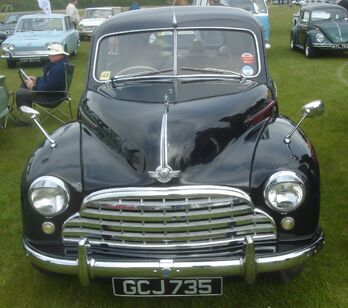
Morris Oxford
Morris Oxford was a series of motor car models produced by the Morris Motor Company of the United Kingdom, from the 1913 "bullnose" Oxford to the 1961–1971 Oxford VI.
Oxford ("bullnose") (1913–14)[]
William Morris' first car was called the Oxford in recognition of its home city. To keep costs down virtually all components were bought-in and assembled by Morris. It was a small car with a 1018 cc four-cylinder side-valve engine with fixed cylinder head from White and Poppe. Ignition was by a Bosch magneto.
The chassis was of pressed-steel construction and suspension was by semi-elliptic leaf springs at the front and three-quarter ones at the rear. The brakes, on the rear wheels only, were external contracting type using metal shoes. A three-forward and reverse gearbox was fitted. The headlights were acetylene and the side and tail lamps oil.
The car got its name from its distinctive round-topped radiator at first called the bullet nose. Most bodies, made by Raworth of Oxford, were of the two-seat open tourer type, there was also a van version, but the chassis was too short to allow four-seat bodies to be fitted.
Oxford (1919–26)[]
The 1919 Oxford was an upmarket version of the Cowley model. It retained the pre-war Bullnose radiator style but in a larger version. The 1548 cc engine was of Continental design made by the British branch of the French Hotchkiss company in Coventry for Morris at prices well undercutting White and Poppe. (Morris bought the British factory in 1923 and changed the name to Morris engines.) In 1923 the engine was enlarged to 1802 cc.
It was differentiated from the Cowley by having a better electrical system and leather upholstery. In 1925 it got a longer wheelbase chassis to move it further from the Cowley, and four-wheel brakes. This model of the Oxford would be the basis of the first MG, the 14/28 Super Sports.
A short-lived six-cylinder variant, The F-Type Oxford Six, was announced in 1920 and was in theory available until 1926. The 2320 cc engine proved unreliable and few were sold. Although the car was longer than the four by 9 inches (230 mm) all the extra space was given over to the engine.
Oxford (Flatnose) (1926–30) & Six (1929–33)[]
The distinctive bullnose radiator was dropped in 1926 in an updated version of the car. The engines remained the same but a new range of bodies was offered including all steel saloons.
A 1938 cc six-cylinder version, the LA series Oxford Six, was made between 1929 and 1933 and was much more successful than the 1920 version. Alongside the tourer and steel saloon, a fabric-bodied car was offered until 1932, when it and the tourer were dropped and a coupé introduced.
In 1932, the gearbox gained a fourth speed and the engine grew to 2062 cc with the Q-series unit.
Oxford Sixteen & Twenty (1934–35)[]
A completely new car was announced for 1934 with a longer and stronger chassis with flexible mounting for the 2002 cc engine. The gearbox gained synchromesh. Initially it kept the Six name but this changed to Sixteen in 1935 when it was joined by the 2561 cc Twenty.
It was replaced by the Fourteen/Sixteen/Eighteen range in 1935 and the Oxford name disappeared until 1948.
Oxford MO (1948–54)[]
After the Second World War the Oxford MO replaced the 10. It was introduced in 1948 and was produced until 1954. The design was shared with Nuffield Organisation stable-mate Wolseley 4/50.
Designed by Alec Issigonis, the Oxford, along with the Morris Minor, introduced unit construction techniques,[clarification needed] although it is not widely recognized as a true unibody car.[clarification needed] Torsion bar front suspension was another novelty, and 8 inch (200 mm) drum brakes hydraulically operated were fitted all around. Under the bonnet, the MO was a step back in technology from the pre-war Ten. It used a side-valve straight-4 rather than the older overhead-valve unit. The single SU-carburetted engine displaced 1.5 L (1476 cc/90 in³) and with its output of 40.5 bhp (30.2 kW) at 4200 rpm could propel the car to 72 mph (116 km/h). The four-speed gearbox had a column gearchange and steering was by rack and pinion.
The MO was sold as a 4-door saloon and 2-door Traveller estate with exposed wood. Both were four-seaters. It was replaced by the Series II Oxford in 1954. The Motor magazine tested a Traveller in 1952 but only attained a top speed of 64 mph (103 km/h) and acceleration from 0–50 mph (80 km/h) in 26.2 seconds. A fuel consumption of 26.4 miles per imperial gallon (10.7 L/100 km; 22.0 mpg-US) was recorded. The test car cost £825 including taxes.
A six cylinder version was sold as the Morris Six MS.
A commercial vehicle version of the Oxford MO was produced from 1950–56 as a van, pickup, or chassis cab model. It used some of the bodywork of the Oxford MO but with a chassis underneath. This was marketed as the Morris Cowley MCV (see photo, below).
Hindustan Motors India produced this car as the Hindustan Fourteen.
Oxford II (1954–56)[]
The Oxford was redesigned for 1954 after the formation of BMC, notably getting the Austin-designed B-Series OHV straight-4. This modern 1.5 L (1489 cc/90 in³) engine produced a respectable 50 hp (37 kW) and allowed the Oxford to reach 74 mph (119 km/h). Hydraulic drum brakes all round were still used but increased to 9-inch (230 mm) diameter. Steering was still of the conventional rack and pinion type.
Styling was revised with perhaps less of a Morris Minor look, though the rounded body still had a family resemblance. Again, a pair of four-seat configurations, 4-door saloon and 2-door Traveller, were offered. The column gear change and front bench seat allowed the saloon to be advertised as a full six seater. The handbrake lever was located between the side of the seat and the driver's side door. Unusually for a British car of its class at the time, the heater was a standard fitting but the radio remained an extra. Sales remained strong when the Series III arrived in 1956.
The British Motor magazine tested a Series II saloon in 1954 recording a top speed of 74.2 mph (119.4 km/h) and acceleration from 0–60 mph (97 km/h) in 28.9 seconds and a fuel consumption of 28.2 miles per imperial gallon (10.0 L/100 km; 23.5 mpg-US). The test car cost £744 including taxes.
A six cylinder version was sold as the Morris Isis.
Hindustan Motors India produced the four cylinder version of this car (except the air-vent situated upon the bonnet) naming it Hindustan Landmaster.
Oxford III (1956–59)[]
The Oxford was updated for 1956 with a new optional two-tone paint scheme, fluted bonnet and small rear fins. Inside the bench seats trimmed in leather remained but the instrument cluster was revised and a new dished steering wheel fitted. The engine now produced 55 hp (41 kW) following an increase in compression ratio though the top speed and acceleration remained the same. A semi-automatic, two pedal, "Manumatic" transmission with centrifugal clutch with vacuum operation coupled to gear changes was optional.
Independent front-suspension with forward torsion bars continued to promise "above average comfort" for the car's occupants.
The woody Series III Traveller was replaced by the Series IV in 1957, though the saloon remained in production until the Pininfarina-styled Series V was introduced in 1959. 58,117 Series III and Series IV Oxfords were built.
Motor magazine tested a Series III manumatic equipped saloon in 1957 recording a top speed of 74.4 mph (119.7 km/h), virtually unchanged from the Series II and acceleration from 0–60 mph (97 km/h) in 30.5 seconds, adversely affected by the Manumatic option. Fuel consumption of 27.0 miles per imperial gallon (10.5 L/100 km; 22.5 mpg-US) was found. The test car cost £898 including taxes of £300.[12] This car was the basis for the Hindustan Ambassador, since 1957 which continues to be built in India some 50 years after the Oxford III's demise, though with a few notable styling updates but keeping the originalities.
Oxford IV (1957–60)[]
The Oxford IV was only made in an estate version. A steel-bodied replacement for the "woody" Series III Traveller, it was similar to the Series III saloon in most respects. The IV was introduced in 1957 and produced alongside the Series V until 1960. An interesting feature was having fillers on both sides of the car, for the single fuel tank.
Oxford V (1959–61)[]
For 1959, the Oxford was merged into the mid-sized Pininfarina-designed BMC Farina range along with a half-dozen other models, including the 1958 Wolseley 15/60 and 1959 Riley 4/68, Austin A55 Cambridge Mark II, and MG Magnette Mark III. The Austin and Morris cars were nearly identical but were produced in separate factories. Differences in the Morris included some of the chrome and interior trim, and the rear lights. Inside, a front bench seat and special dashboard fitted with speedometer, oil pressure gauge, coolant temperature gauge, fuel gauge and clock (optional) were used. A choice of floor or column gear change was available. The handbrake was floor mounted to the side of the seat. The 1.5 L B-Series engine continued. Drum brakes of 9 in (230 mm) diameter were fitted front and rear and the steering used a cam and peg system. The suspension was independent at the front using coil springs and had a live axle and semi-elliptic leaf springs at the rear.
The Series IV Traveller was still sold for the first year after which a Series V Traveller was made.
When tested by The Motor magazine the car had a top speed of 78 mph (126 km/h) and could accelerate from 0–60 mph (97 km/h) in 25.4 seconds. A "touring" fuel consumption of 29.8 miles per imperial gallon was recorded.
Both standard and de-luxe versions were offered. The de-luxe package included a heater, manual screen washer, twin sun visors, twin horns, bumper over-riders, a clock and leather-covered seat. A two-tone paint scheme and a radio were available as options.
On the home market the Standard version cost £815 and the de-luxe £844 including taxes.
In all, 87,432 Series V Oxfords were built.
Oxford VI (1961–71[]
All five Farina cars were updated in 1961 with a new 1.6 L (1622 cc/98 in³) version of the B-Series engine and a new revised look. The tail fins had been trimmed and there were still detail changes between the marques. The Morris retained the Series V dash, while the Austin had an all-new fake woodgrain design. The Morris Oxford Traveller (estate) Mark V was replaced by a Mark VI, although little changed apart from the front grille.
A diesel-engined Oxford Mark VI, introduced shortly after the 1961 update, was popular as a taxi. Variants of the same diesel engine enjoyed a long life in marine applications.
The Oxford VI remained in production until 1971 with 208,823 produced. The Oxford range was to have been replaced by the 1967 Morris 1800 (a badge-engineered 1964 ADO17 Austin 1800), but in the event both were built in parallel until 1971 because in terms both of pricing and of interior space the 1800 fell into the market segment of a slightly larger car. The ADO17 1800 continued until 1975, when it was succeeded by the ADO71 Morris 1800. The car which took the Oxford's place at the smaller end of the market segment was the Morris Marina, which also succeeded the yet smaller Minor.
Celebrity connection[]
In July 1967 the log book of a 1964 Morris Oxford was sold to an American collector. The sale was reported in the press because the car's original owner, by then deceased, had been Sir Winston Churchill, the former British prime minister.

